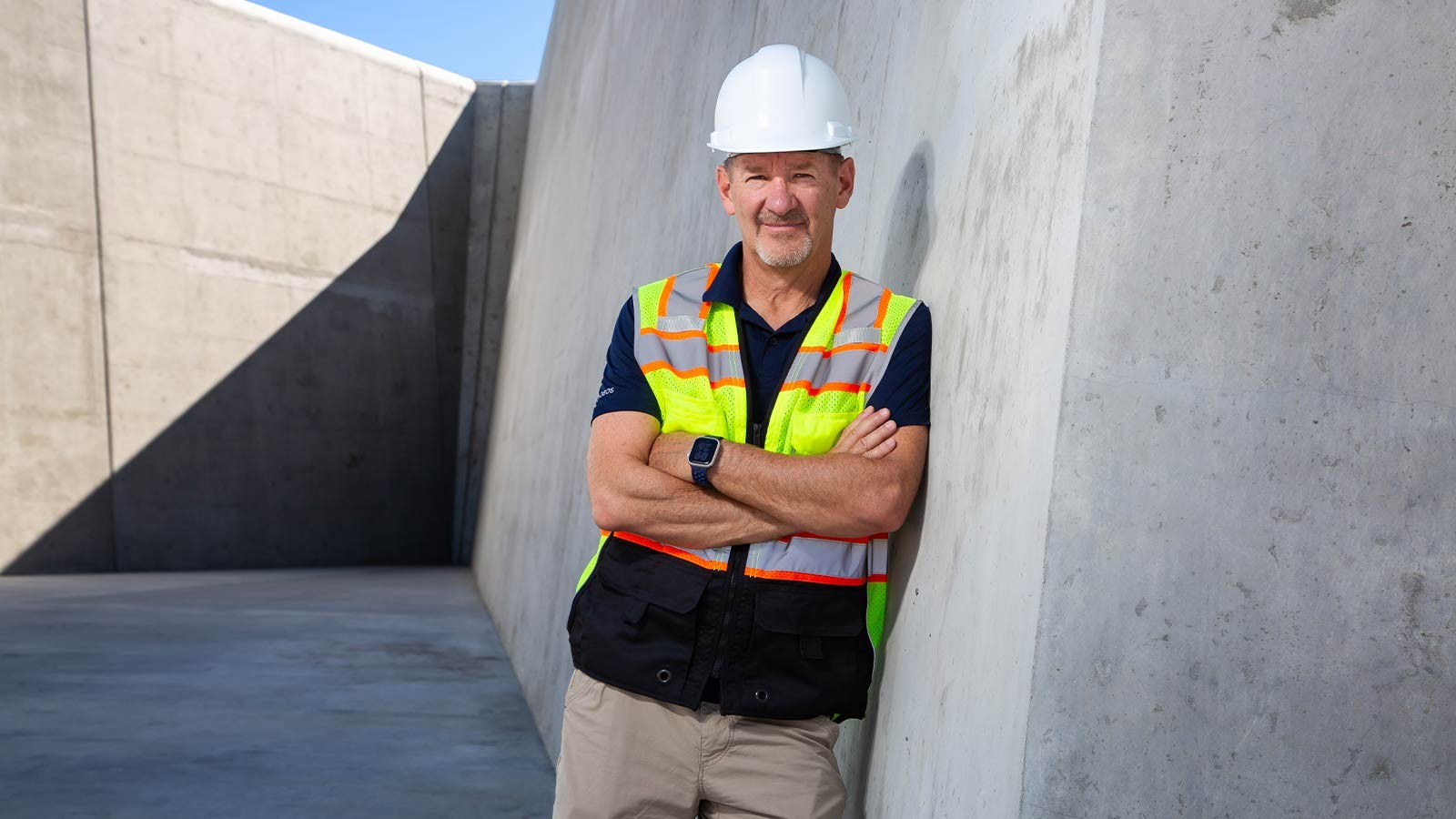USU-Inspired Labyrinth Weir Takes Shape at California's Isabella Dam
By Matt Jensen |
Blake Tullis served as the lead engineer on the Isabella model study, which helped inform the design of the structure and reduce its construction costs. Tullis visited the dam site during its final stages of construction in July 2023. (Photo Credit: Matt Jensen)
How do you maximize the length of a line that fits inside a confined space? One option is to fold the line into a zigzag. Another is to curve the line. How about a combination of both? That’s the idea that started at the Utah Water Research Laboratory decades ago. Today, that concept is a concrete reality in Southern California.
Many dams around the world feature a spillway structure with a weir, which allows water to flow out of a reservoir at controlled rates. When water reaches the top of the weir, it spills over and flows to the downstream side. But with a changing climate punctuated by extreme weather, civil engineers are increasingly concerned about the ability of conventional weirs to control the occasional, record-smashing outflow.
“Flow over a weir is proportional to its length. A longer weir has more flow than a short weir,” says Blake Tullis, a professor of civil and environmental engineering and an associate vice president for research at USU. “In the event of a probable maximum flood, a short weir may be insufficient for high outflows. If water can’t flow through a spillway, it will build up in the reservoir and eventually overtop the dam, which could lead to a major failure.”
That idea has led to transformational change in spillway design. At Lake Isabella — about an hour east of Bakersfield — a 70-year-old service spillway controls outflow for two earthen dams at the site. The spillway can discharge about 120,000 cubic feet of water per second, far short of the estimated half-million required during a maximum precipitation event. In 2005, the U.S. Army Corps of Engineers began an extensive dam safety study at Isabella, which identified important safety modification needs. In 2017, construction began on a new emergency spillway that defies conventional thinking.
It was Tullis’ father, Paul Tullis, who first wrote about the concept of a labyrinth weir. Blake Tullis and his doctorate student at the time, Brian Crookston, took that original idea and turned it into reality when they published a formal paper about arced labyrinth weirs in 2012. Around that same time, the Army Corps of Engineers Sacramento District was looking for solutions for Isabella’s new spillway and turned to the Utah Water Research Lab for help.
“We shared our paper with them, and that led to a formal study and the creation of the largest physical model we had ever built at the lab,” said Tullis, who served as lead engineer on the Isabella model. “Here we are nearly 10 years later looking at the completed structure. It’s an engineering marvel. For me, seeing it finished just confirms that the work we’re doing at the Water Lab is making real impact all around the world.”
The pristine, labyrinth weir arcs gently into the reservoir, zigzagging its way across the spillway channel. Stretched out to a straight line, it would be 3,100 feet long — nearly three times longer than the width of the channel in which it stands.
Tullis has long been a proponent of translational research, a term that describes practical solutions to complex, real-world engineering challenges.
“One of our missions at the Water Lab is to carry out translational research that reduces risk and uncertainty for our clients,” he added. “And it provides a rich, educational experience for our students that they won’t find at other institutions.”
It was that mission and the expertise of the Water Lab staff that helped inform decision makers on the Isabella Dam Safety Modification Project. David Serafini of the U.S. Army Corps of Engineers says the 1:45 scale model confirmed the spillway design and led to significant cost savings.
“The labyrinth weir was a clear choice in order to reduce the width and the overall excavation footprint for a new spillway,” said Serafini, a lead engineer and principal in charge of the Isabella project.
Serafini visited the Water Lab during testing to see the model in action. The zigzag shape confirmed the labyrinth weir could accommodate unprecedented outflows. It also revealed an unexpected finding.
During a visit to the lab in 2014, Serafini and Tullis determined that the spillway channel could be narrower than originally designed. The change would mean thousands of tons of granite in the spillway chute could be left untouched, reducing excavation time and costs.
“We didn’t want to dig wider or deeper than we had to because that would mean excavating solid granite out of the surrounding terrain,” Serafini said.
With construction nearly complete at Isabella, Tullis and the many engineers who worked on the project are reflecting on what it took to build the weir and the implications it has for the civil engineering and dam safety communities around the world.
“It’s an impressive structure,” Serafini said. “And yet, I hope we never see it functioning as it is an emergency spillway to protect the two dams from being overtopped.”
WRITER
Matt Jensen
Public Relations and Marketing Director
College of Engineering
435-797-8170
matthew.jensen@usu.edu
TOPICS
Engineering 337stories Environment 263storiesComments and questions regarding this article may be directed to the contact person listed on this page.







